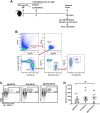IgE-activated mast cells enhance TLR4-mediated antigen-specific CD4+ T cell responses
- PMID: 33958642
- PMCID: PMC8102524
- DOI: 10.1038/s41598-021-88956-4
IgE-activated mast cells enhance TLR4-mediated antigen-specific CD4+ T cell responses
Abstract
Mast cells are potent mediators of allergy and asthma, yet their role in regulating adaptive immunity remains ambiguous. On the surface of mast cells, the crosslinking of IgE bound to FcεRI by a specific antigen recognized by that IgE triggers the release of immune mediators such as histamine and cytokines capable of activating other immune cells; however, little is known about the mast cell contribution to the induction of endogenous, antigen-specific CD4+ T cells. Here we examined the effects of specific mast cell activation in vivo on the initiation of an antigen-specific CD4+ T cell response. While CD4+ T cells were not enhanced by FcεRI stimulation alone, their activation was synergistically enhanced when FcεRI activation was combined with TLR4 stimulation. This enhanced activation was dependent on global TLR4 stimulation but appeared to be less dependent on mast cell expressed TLR4. This study provides important new evidence to support the role of mast cells as mediators of the antigen-specific adaptive immune response.
Conflict of interest statement
The authors declare no competing interests.
Figures





Similar articles
-
Mast cell-mediated immune responses through IgE antibody and Toll-like receptor 4 by malarial peroxiredoxin.Eur J Immunol. 2008 May;38(5):1341-50. doi: 10.1002/eji.200738059. Eur J Immunol. 2008. PMID: 18398934
-
FcepsilonRI-alpha siRNA inhibits the antigen-induced activation of mast cells.Iran J Allergy Asthma Immunol. 2009 Dec;8(4):177-83. Iran J Allergy Asthma Immunol. 2009. PMID: 20404387
-
Indirect involvement of allergen-captured mast cells in antigen presentation.Blood. 2008 Feb 1;111(3):1489-96. doi: 10.1182/blood-2007-07-102111. Epub 2007 Nov 21. Blood. 2008. PMID: 18032707 Free PMC article.
-
[Role of Histamine-releasing Factor in Allergic Inflammatory Reactions].Yakugaku Zasshi. 2017;137(5):517-521. doi: 10.1248/yakushi.16-00239-3. Yakugaku Zasshi. 2017. PMID: 28458281 Review. Japanese.
-
Monomeric IgE and mast cell development, survival and function.Adv Exp Med Biol. 2011;716:29-46. doi: 10.1007/978-1-4419-9533-9_3. Adv Exp Med Biol. 2011. PMID: 21713650 Review.
Cited by
-
Comparative analyses of various IgE-mediated and non-IgE-mediated inducers of mast cell degranulation for in vitro study.Immunol Res. 2024 Apr;72(2):331-346. doi: 10.1007/s12026-023-09438-5. Epub 2023 Nov 25. Immunol Res. 2024. PMID: 38001385
-
The Association of Nasal and Blood Eosinophils with Serum IgE Level in Allergic Rhinitis and Asthma: A Case-Control Study.Health Sci Rep. 2024 Nov 7;7(11):e70191. doi: 10.1002/hsr2.70191. eCollection 2024 Nov. Health Sci Rep. 2024. PMID: 39512245 Free PMC article.
-
Conventional and non-conventional antigen presentation by mast cells.Discov Immunol. 2023 Sep 19;2(1):kyad016. doi: 10.1093/discim/kyad016. eCollection 2023. Discov Immunol. 2023. PMID: 38567067 Free PMC article. Review.
-
Toll-like receptor 2/6-stimulated HMC-1 mast cells promote keratinocyte migration in wound healing.PLoS One. 2025 Jan 17;20(1):e0317766. doi: 10.1371/journal.pone.0317766. eCollection 2025. PLoS One. 2025. PMID: 39823483 Free PMC article.
-
The Effects of Saposhnikovia divaricata Aqueous Extracts on the Inflammation and Intestinal Microflora in Allergic Rhinitis Mice.Evid Based Complement Alternat Med. 2022 Oct 14;2022:1052359. doi: 10.1155/2022/1052359. eCollection 2022. Evid Based Complement Alternat Med. 2022. PMID: 36276863 Free PMC article.
References
Publication types
MeSH terms
Substances
Grants and funding
LinkOut - more resources
Full Text Sources
Other Literature Sources
Molecular Biology Databases
Research Materials

